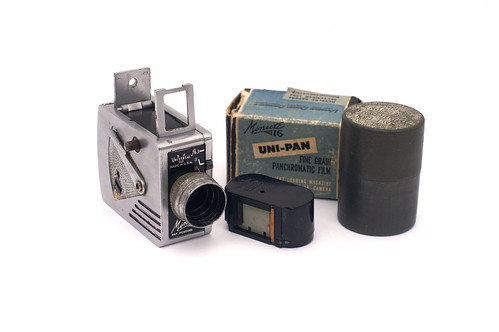Difference between revisions of "Universal Minute 16"
Tarn McDaddo (talk | contribs) m (Added information about models with f/8 marking also) |
Tarn McDaddo (talk | contribs) m (corrected the single shutter speed, as listed in the manual) |
||
| Line 10: | Line 10: | ||
The '''Minute 16''' is a sub-miniature camera for 16mm perforated film in re-loadable cartridges. It was introduced 1949 by the [[Universal|Universal Camera Corp.]] of New York, NY, USA, a company perhaps best known for the Univex cameras of the 1930s. The introduction of the Minute 16 did not prevent the Corporation from going bankrupt 1952. | The '''Minute 16''' is a sub-miniature camera for 16mm perforated film in re-loadable cartridges. It was introduced 1949 by the [[Universal|Universal Camera Corp.]] of New York, NY, USA, a company perhaps best known for the Univex cameras of the 1930s. The introduction of the Minute 16 did not prevent the Corporation from going bankrupt 1952. | ||
| − | The tiny chromed metal camera looks like a cine camera with the traditional foldable frame finder at the top. It has a [[meniscus lens|meniscus]] lens set deep in an aluminium lens barrel with a small aperture selector lever marked f6.3 - 11 - 16 next to it. Some versions (perhaps later versions?) also include a marking for f/8 between the f/6.3 and f/11 markings. The lever on the right-hand side winds the camera, and the release push button is situated just above it. A manually reset frame-counter is just below the lever. A 1/ | + | The tiny chromed metal camera looks like a cine camera with the traditional foldable frame finder at the top. It has a [[meniscus lens|meniscus]] lens set deep in an aluminium lens barrel with a small aperture selector lever marked f6.3 - 11 - 16 next to it. Some versions (perhaps later versions?) also include a marking for f/8 between the f/6.3 and f/11 markings. The lever on the right-hand side winds the camera, and the release push button is situated just above it. A manually reset frame-counter is just below the lever. A 1/50 sec. single-speed semi-cylinder guillotine [[shutter]] is placed behind the lens. |
A remarkable feature is the tripod-socket at the camera base, which doubles as a flash synch-contact; a rare feature also found on the 35mm [[SLR]] [[Contax S]] introduced the same year as the Minute-16. For the especially interested collector the camera must be in its original box and with its huge flashlight in the style of a professional [[strobe]] with side bracket. The simple, but quite solidly made camera, is very common on its own. | A remarkable feature is the tripod-socket at the camera base, which doubles as a flash synch-contact; a rare feature also found on the 35mm [[SLR]] [[Contax S]] introduced the same year as the Minute-16. For the especially interested collector the camera must be in its original box and with its huge flashlight in the style of a professional [[strobe]] with side bracket. The simple, but quite solidly made camera, is very common on its own. | ||
| Line 21: | Line 21: | ||
*Year of launch: 1949 | *Year of launch: 1949 | ||
*Film/frame-size: 16mm [[cassette film|film cassette]]/10×14mm | *Film/frame-size: 16mm [[cassette film|film cassette]]/10×14mm | ||
| − | *Shutter: Guillotine shutter with speed 1/ | + | *Shutter: Guillotine shutter with speed 1/50 sec. |
*Lens: meniscus lens | *Lens: meniscus lens | ||
*Aperture: f/6.3, f/11 and f/16 (some versions also include f/8) | *Aperture: f/6.3, f/11 and f/16 (some versions also include f/8) | ||
Revision as of 06:03, 9 November 2021

|
| image by Steve Harwood (Image rights) |
The Minute 16 is a sub-miniature camera for 16mm perforated film in re-loadable cartridges. It was introduced 1949 by the Universal Camera Corp. of New York, NY, USA, a company perhaps best known for the Univex cameras of the 1930s. The introduction of the Minute 16 did not prevent the Corporation from going bankrupt 1952.
The tiny chromed metal camera looks like a cine camera with the traditional foldable frame finder at the top. It has a meniscus lens set deep in an aluminium lens barrel with a small aperture selector lever marked f6.3 - 11 - 16 next to it. Some versions (perhaps later versions?) also include a marking for f/8 between the f/6.3 and f/11 markings. The lever on the right-hand side winds the camera, and the release push button is situated just above it. A manually reset frame-counter is just below the lever. A 1/50 sec. single-speed semi-cylinder guillotine shutter is placed behind the lens.
A remarkable feature is the tripod-socket at the camera base, which doubles as a flash synch-contact; a rare feature also found on the 35mm SLR Contax S introduced the same year as the Minute-16. For the especially interested collector the camera must be in its original box and with its huge flashlight in the style of a professional strobe with side bracket. The simple, but quite solidly made camera, is very common on its own.
Specifications
- Type: sub-miniature viewfinder camera
- Manufacturer: Universal Camera Corp. of New York, NY.
- Year of launch: 1949
- Film/frame-size: 16mm film cassette/10×14mm
- Shutter: Guillotine shutter with speed 1/50 sec.
- Lens: meniscus lens
- Aperture: f/6.3, f/11 and f/16 (some versions also include f/8)
- Viewfinder: two-piece foldable sports finder
- Film advance: lever
- Flashlight
Links
- Universal Minute 16 user manual at Butkus.org
- Minute 16 at submin.com
- Minute 16 at Collection G. Even's site (in French)